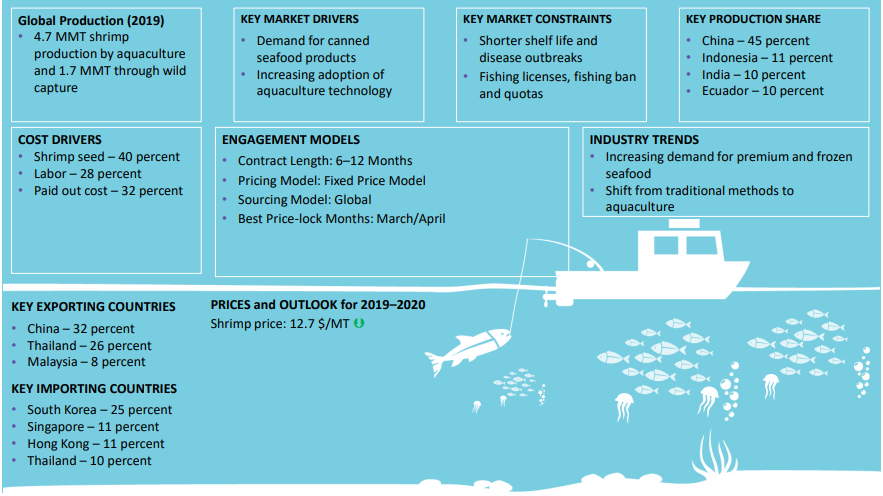CATEGORY
Shrimp
Beroe LiVE.Ai™
AI-powered self-service platform for all your sourcing decision needs across 1,200+ categories like Shrimp.
Market Data, Sourcing & Supplier Intelligence, and Price & Cost Benchmarking.
Schedule a DemoCategory Alerts
Ecuador's shrimp exports to be impacted by earthquake and floods
April 04, 2023Black Tiger Shrimp demand to improve as Vannamei farms face threat of diseases
January 23, 2023Thailand to import 10,500 tonnes of shrimp
August 09, 2022Become a Beroe LiVE.Ai™ Subscriber to receive proactive alerts on Shrimp
Schedule a DemoShrimp Market Monitoring Dashboard
Understand the correlation between costs, margins, and prices impacting your category on a real time basis on Beroe LiVE.Ai™
Schedule a DemoShrimp Industry Benchmarks
Savings Achieved
(in %)
The average annual savings achieved in Shrimp category is 5.30%
Payment Terms
(in days)
The industry average payment terms in Shrimp category for the current quarter is 75.6 days
Compare your category performance against peers and industry benchmarks across 20+ parameters on Beroe LiVE.Ai™
Category Strategy and Flexibility
Engagement Model
Supply Assurance
Sourcing Process
Supplier Type
Pricing Model
Contract Length
SLAs/KPIs
Lead Time
Supplier Diversity
Targeted Savings
Risk Mitigation
Financial Risk
Sanctions
AMEs
Geopolitical Risk
Cost Optimization
Price per Unit Competitiveness
Specification Leanness
Minimum Order Quality
Payment Terms
Inventory Control
The World’s first Digital Market Analyst
Abi, the AI-powered digital assistant brings together data, insights, and intelligence for faster answers to sourcing questions
Abi is now supercharged with GPT4 AI engine. Enjoy the ease of ChatGPT, now on Abi

Use the Shrimp market, supplier and price information for category strategy creation and Quaterly Business Reviews (QRBs)
Schedule a DemoShrimp market frequently asked questions
Increasing consumption of processed/ready-to-cook (RTC) seafood and rising disposable income are major driving forces for the global shrimp market. In addition, market players are increasingly adopting aquaculture technology to gain a competitive edge.
China, accounting for nearly half of the global shrimp production, will continue to attract stakeholders over the forecast period. The majority of the supply comes from aquaculture and wild capture. Despite the reduced shrimp demand in 2020 due to the COVID-19, China’s shrimp market is poised to make a gradual rebound.
As per Beroe’s category intelligence study, the global shrimp production is expected to surpass 6 MMT, at a 4% CAGR.
China (32%) is the leading shrimp exporter, followed by Thailand (26%) and Malaysia (8%).
Surging demand for frozen and premium seafood and rapid shift from conventional agricultural methods to tech-driven aquaculture practices are the key trends impacting the global shrimp market growth.
South Korea makes up for a quarter of the global shrimp import, with Singapore and Hong Kong share the same divide, followed by Thailand.
Governments worldwide have imposed their own control mechanism to avoid overfishing and exhaustion of resources. For example, countries including China and Thailand have enabled fishing licenses and quotas for their fisheries and seafood industries.
Seafood raising and processing are subject to disease outbreaks. For instance, early mortality syndrome (EMS) has led to a significant decline in shrimp production in China, Vietnam, and Indonesia.
Shrimp market report transcript
Global Market Overview on Shrimp
-
The global seafood industry is highly fragmented, with a supply of approx. 180 MMT of fishes annually (both wild caught and aquaculture, 2021) and is estimated to reach 181 MMT in 2022.
-
Fish capture over the decade has taken a more inland approach with the major capture type being aquaculture and tuna, shrimp, salmon are the most captured and traded species
-
Aquaculture currently holds 48 percent of the market share, and it is expected to increase its share in the total capture beyond 50 percent by the end of 2022
Market Drivers and Constraints : Shrimp
The important driver for the seafood market is the increasing demand from the frozen ready-to-cook seafood industry, while the major constraints currently are the disease outbreaks and the costs incurred in ensuring a disease-free environment.
Drivers
Increasing demand for processed/ready-to-cook seafood:
-
The seafood industry is gaining momentum, due to convenience and time-saving factors
-
Increasing disposable income and per capita consumption are also seen favorable for the growth of the industry
R&D/technology:
-
Aquaculture is gaining dominance over traditional agricultural practices, wild fish harvesting, etc., due to its volume production
Constraints
Shorter shelf life and disease outbreaks:
-
Disease outbreaks can occur both during raising and processing seafood. EMS or Early Mortality Syndrome had caused a substantial decrease in the shrimp production of the leading countries, like China, Vietnam, Indonesia, etc.
Government regulations:
-
Every country has its own control mechanism to prevent overfishing and the exhaustion of its resources. Countries, like Thailand, China, have fishing quotas and licenses in place, with respect to their fisheries and seafood industry
Supply–Demand Analysis : Shrimp
-
Global shrimp production is estimated at 6.6 MMT in 2023, with an average growth rate of 4.2 percent, with the supply facing glut in the global market.
-
Currently, about 71 percent of the shrimp supply is through aquaculture, then wild capture, with China occupying majority of share in harvesting both types of supply
-
Demand for shelf stable canned shrimp could increase in 2022
Interesting Reads:
Discover the world of market intelligence and how it can elevate your business strategies.
Learn more about how market intelligence can enable informed decision-making, help identify growth opportunities, manage risks, and shape your business's strategic direction.
